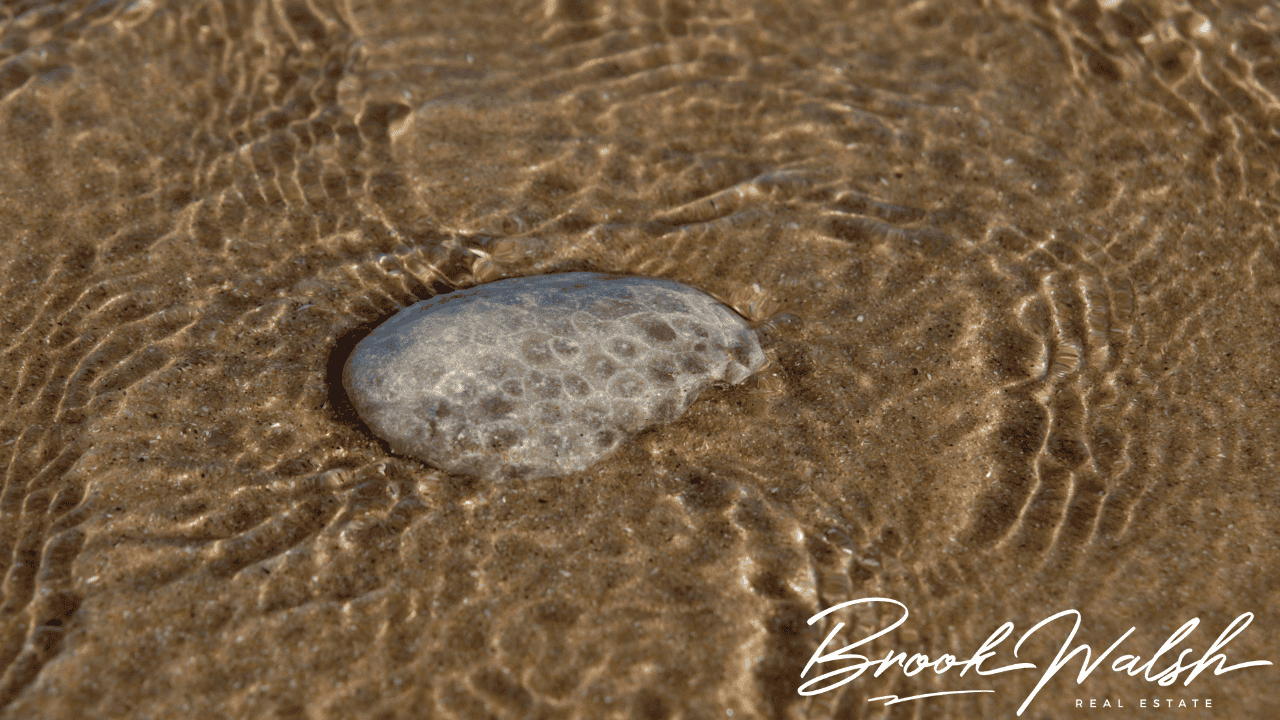Lake Charlevoix Petoskey Stones: A Stunning Natural Gem Revealed
Discover everything about Lake Charlevoix Petoskey Stones — from their ancient fossil origins to the best spots for collecting them, this guide unveils a true Michigan treasure.
Introduction to Lake Charlevoix and Petoskey Stones

Tucked away in the heart of northern Michigan lies a pristine freshwater jewel — Lake Charlevoix. With its shimmering waters, lush surroundings, and charming shoreline towns, the lake is a destination of peace and natural beauty. But among its many wonders lies a hidden treasure that has fascinated visitors and locals alike for generations — the Petoskey Stone.
A Petoskey stone isn’t just a rock. It’s a fossilized coral, dating back over 350 million years, that tells a story of ancient seas and prehistoric life. Named after the nearby town of Petoskey, these stones captivate with their unique hexagonal patterns and soft gray hues. Though often associated with Lake Michigan, Lake Charlevoix has become a lesser-known haven for discovering these geological gems.
Whether you're a curious beachcomber, an avid rockhound, or a family looking for a fun outdoor activity, this guide will walk you through the origin, beauty, and joy of finding Lake Charlevoix Petoskey Stones.
The Geological Origins of Petoskey Stones
Petoskey stones are not just rocks — they're fossilized rugose corals known as Hexagonaria percarinata. These corals lived during the Devonian Period, roughly 350 to 400 million years ago, when Michigan was covered by a warm, shallow sea. Over millions of years, these coral beds were buried, compacted, and transformed into limestone, preserving the unique honeycomb-like pattern we see today.
During the Ice Age, glaciers ground the fossil-bearing limestone into smaller fragments and scattered them throughout Michigan’s lower peninsula. As glaciers melted and retreated, they left behind these stone remnants along the lakeshores — including those of Lake Charlevoix.
What makes these stones so appealing is their geometric, six-sided patterns. The soft coral centers contrast beautifully with the polished edges once the stone is wet or polished — revealing the full fossil detail.
Why Lake Charlevoix is a Hotspot for Petoskey Stones

While Lake Michigan gets most of the credit, Lake Charlevoix offers an abundance of Petoskey stones without the crowds. Why? It comes down to geology and geography.
Lake Charlevoix sits in the northern Lower Peninsula, within the Petoskey formation range. Its smaller size and less turbulent waves mean stones are less likely to be crushed or buried deep under the sand. Its gentle shorelines make beachcombing easier — perfect for families and beginners.
The sediment and wave action here gently expose stones after storms, especially in spring when snowmelt boosts water movement. You’ll find these stones scattered along the beaches or hiding among pebbles on shallow lake beds.
Identifying Authentic Petoskey Stones
Not every patterned rock is a Petoskey stone. To know what you’re looking for:
-
Look for the Pattern: A hexagonal honeycomb structure is the tell-tale sign.
-
Color & Texture: Typically gray to light brown with lighter centers. When dry, they appear dull; when wet or polished, they glow.
-
Weight: Heavier than typical rocks due to their fossil makeup.
-
Shape: Often rounded from years of wave polishing.
Be careful not to confuse them with Charlevoix stones, which are also fossilized coral but have a slightly different pattern.
Best Beaches and Spots Near Lake Charlevoix for Stone Hunting

Lake Charlevoix boasts several prime locations for uncovering Petoskey stones. These spots offer scenic beauty and a great chance to add to your fossil collection:
1. Fisherman’s Island State Park
Though slightly southwest of Lake Charlevoix, this park is a top destination for stone seekers. Its shoreline is scattered with fossil-rich stones and driftwood. Early morning visits after a storm yield the best results.
2. Young State Park
Situated on the northeast side of Lake Charlevoix, this park offers sandy beaches and shallow waters, ideal for wading and searching for Petoskey stones. The clear waters help reveal the distinctive patterns underwater.
3. Depot Beach
Located right in Charlevoix, this family-friendly beach is not only a great place to relax but also a lesser-known haven for fossil hunters. Explore near the water’s edge or along the rocky outcroppings.
4. Whiting Park
On the southern side of the lake, Whiting Park is another spot with minimal crowds and surprising fossil finds, especially after wind-driven waves stir the shore.
Tip: Bring a mesh bag, small scoop, or garden trowel. Gently sift through sand and rocks — many Petoskey stones hide just beneath the surface.
Seasonal Tips for Finding Petoskey Stones
Finding Petoskey stones can be done year-round, but certain seasons improve your odds.
-
Spring: Melting snow and rising lake levels expose fresh layers of stones. Post-storm walks are especially fruitful.
-
Summer: Best for family-friendly searches, thanks to warm weather. Try early mornings before the beaches fill up.
-
Autumn: Crisp air and fewer tourists make fall an ideal time. Falling leaves add color, and storms stir up the beaches.
-
Winter: Challenging but not impossible. If snow is light and the lake isn’t frozen, you might uncover stones in newly exposed areas.
Regardless of the season, waterproof boots and patience go a long way.
Tools and Techniques for Collecting Petoskey Stones
Stone collecting doesn’t require fancy tools, but the right techniques can improve your success rate:
Recommended Tools:
-
Mesh bags or old pillowcases to carry finds
-
Handheld scoops or trowels for shallow digging
-
Magnifying glass to examine patterns
-
Spray bottle of water to reveal hidden details
Techniques:
-
Wet Stones First: Petoskey stones reveal their iconic pattern when wet. A splash of lake water or a spritz from a spray bottle helps.
-
Slow and Steady: Walk slowly along the shoreline and keep your eyes peeled for circular, flower-like patterns.
-
Wade In: Sometimes, the best stones lie just under the surface in shallow water.
-
After the Storm: Strong waves often bring new stones to shore.
Patience and observation are key. The more time you spend, the more rewarding your search will be.
Cleaning and Polishing Your Petoskey Stones

Once you've found your stone, it's time to bring out its true beauty.
Basic Cleaning:
-
Rinse the stone in fresh water.
-
Use a soft toothbrush to remove sand and dirt.
-
Let it dry completely.
Polishing Methods:
-
Sandpaper Method:
-
Start with 220-grit wet/dry sandpaper and work up to 600 or 1200 grit.
-
Always sand under water to reduce dust.
-
Finish with a polishing compound like cerium oxide.
-
-
Polishing Kit: Rock tumblers or hand-polishing kits can give a glassy finish over time.
-
Natural Finish: Some prefer leaving the stone in its raw form for a more organic look.
Whether polished to a shine or kept rustic, your Petoskey stone becomes a tangible memory of your lakeside adventure.
Laws and Regulations on Stone Collecting in Michigan
Before collecting, it’s important to know the rules:
-
Legal Limits: Michigan law allows individuals to collect up to 25 pounds of rocks, minerals, or fossils per year from public land, including state parks.
-
No Tools in Parks: Use of mechanical tools in state parks is prohibited.
-
Respect Private Property: Always ask permission before collecting on private land.
-
Leave No Trace: Don’t disturb the environment or take more than you need.
These guidelines ensure that future generations can also enjoy the thrill of discovery.
Local Folklore and Legends about Petoskey Stones
Petoskey stones hold a unique place in Michigan’s cultural tapestry. According to local legend, the stones are named after a 19th-century Ottawa chief, Petosegay. His name means “rising sun,” and the flower-like pattern of the stone is seen as a symbol of light and life.
Stories also tell of the stones being lucky charms, carried by Great Lakes sailors to ensure safe passage. Today, many people still gift polished Petoskey stones as tokens of good fortune or symbols of northern Michigan pride.
Ecological Considerations and Responsible Collecting

While collecting stones can be exciting, it’s vital to collect responsibly:
-
Avoid Over-Collecting: Take only what you love, leave the rest for nature and others.
-
Don’t Disturb Wildlife: Be mindful of shorebirds, turtles, and other creatures.
-
Clean Footwear: To prevent spreading invasive species, clean your shoes and gear after your visit.
Being a respectful rockhound helps preserve Michigan’s beauty for generations to come.
Petoskey Stone Souvenirs and Art from Lake Charlevoix
Once you’ve collected or admired a Petoskey stone, the next step is often turning it into something beautiful. Northern Michigan, especially around Lake Charlevoix, has a vibrant community of artisans who specialize in transforming these ancient fossils into unique works of art.
Popular Petoskey Stone Creations:
-
Jewelry: Necklaces, bracelets, and earrings featuring polished stones set in sterling silver or copper.
-
Home Décor: Bookends, coasters, and even cabinet knobs made from larger stones.
-
Carvings and Sculptures: Local artists create animal shapes, paperweights, and abstract designs.
-
Custom Engravings: Personalized Petoskey stone gifts are popular for weddings, anniversaries, and memorials.
Visit downtown Charlevoix or Petoskey for gift shops and galleries. Many stores, like The Rocking Horse Toy Company or American Spoon, also sell regionally made stone items alongside local foods and crafts.
Family-Friendly Activities Around Lake Charlevoix

Beyond stone hunting, Lake Charlevoix offers plenty for families to enjoy:
Outdoor Fun:
-
Boating & Kayaking: Explore the lake’s calm waters or rent a pontoon for a day on the water.
-
Swimming: Sandy beaches like Depot Beach and Ferry Beach are perfect for kids.
-
Camping: Young State Park offers well-maintained campgrounds with access to trails and beaches.
-
Hiking & Biking: Trails like the Little Traverse Wheelway connect Lake Charlevoix to other scenic areas.
Stone-Themed Treasure Hunts:
Organize your own fossil scavenger hunt with maps, clues, and small prizes. It's an educational and adventurous way to keep children engaged while appreciating nature.
Exploring Nearby Charlevoix and Petoskey Towns
Both Charlevoix and Petoskey are charming towns packed with personality, history, and family-friendly attractions.
Charlevoix Highlights:
-
Mushroom Houses: Take a tour of the whimsical homes built by Earl Young.
-
Charlevoix Lighthouse: A favorite photography spot with stunning sunset views.
-
Downtown Boutiques: Shop for local crafts, antiques, and tasty treats.
Petoskey Attractions:
-
Bear River Recreation Area: Offers trails and whitewater kayaking within the city.
-
Petoskey State Park: A beautiful place for more Petoskey stone hunting.
-
Gaslight District: Full of quaint shops, eateries, and historical charm.
These towns provide a perfect balance of nature, culture, and small-town hospitality.
The Science Behind Petoskey Stones’ Beauty
Why do Petoskey stones look so striking?
The answer lies in paleontology and geology. The fossilized coral in these stones, Hexagonaria percarinata, displays a perfect pattern of hexagonal corallites—tiny coral skeletons. Each cell once housed a living organism that contributed to a vast underwater reef system.
When polished or wet, light reflects differently off the fossilized parts, revealing a stunning contrast between the outer walls and inner chambers. This natural design showcases both symmetry and randomness—one of nature’s artistic masterpieces.
Modern science continues to study these fossils to better understand ancient marine environments, coral extinction patterns, and climate shifts over millions of years.
Where to Stay: Book a Cozy Retreat with Northern Michigan Escapes
After a full day of exploring the shores of Lake Charlevoix and hunting for Petoskey stones, you'll need a comfortable place to rest and recharge. Northern Michigan Escapes offers a wide range of vacation rentals that put you right near the action — from charming lakeside cottages to luxury condos and spacious family homes.
Whether you're planning a romantic getaway, a family vacation, or a solo adventure, Northern Michigan Escapes has the perfect lodging option to suit your needs. Their properties are fully equipped, beautifully maintained, and located near all the best beaches, parks, and downtown attractions.
✨ Book your stay with Northern Michigan Escapes and turn your fossil-hunting trip into a relaxing northern Michigan getaway.
Frequently Asked Questions About Petoskey Stones

1. Are Petoskey stones only found in Michigan?
A. Yes, they are unique to Michigan, particularly around the Lake Michigan shoreline and Lake Charlevoix area.
2. Can I legally take Petoskey stones home with me?
A. Yes, individuals may collect up to 25 pounds per year from public lands in Michigan. Avoid collecting in protected areas or using mechanical tools.
3. How can I tell if a stone is a real Petoskey stone?
A. Look for the hexagonal pattern. The stone is dull when dry and vibrant when wet. It has a distinct soft texture when polished.
4. Are there other types of fossil stones in the area?
A. Yes, Charlevoix stones and Favosite corals are other fossilized corals that you may find, each with different patterns.
5. What’s the best time of year to find Petoskey stones?
A. Spring and fall, especially after storms, are the best times due to shifting sand and increased wave action revealing new stones.
6. Can I polish a Petoskey stone at home?
A. Absolutely. All you need is wet/dry sandpaper (starting at 220 grit up to 1200) and some polishing compound. It’s a fun and rewarding DIY project.
Conclusion: The Magic of Lake Charlevoix and Its Fossil Treasures

Lake Charlevoix offers more than breathtaking views — it’s a gateway into Earth’s ancient past. The thrill of discovering Lake Charlevoix Petoskey Stones lies not just in the hunt, but in the history each stone holds. These beautiful fossils, shaped by millennia of geological processes, are Michigan’s natural legacy.
Whether you're a geologist, a nature lover, or a curious traveler, Lake Charlevoix invites you to walk its shores, feel the cool breeze, and perhaps, with a bit of luck, find your own piece of prehistoric beauty.
So grab your bucket, bring your sense of wonder, and start your fossil adventure today!
Posted by Brook Walsh on

Leave A Comment